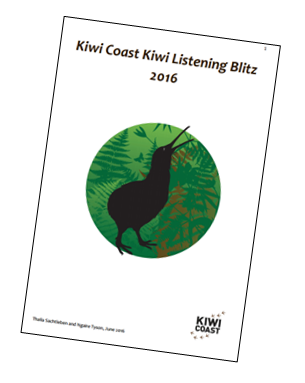The Kiwi Coast ‘Kiwi Listening Blitz’ Report is now available. This report provides crucial monitoring information for the Kiwi Coast and over time, will help prove if the initiative is working or not.
 As the Kiwi Coast grows, there is a need to monitor kiwi numbers and distribution across eastern Northland, to document the effects that conservation efforts such as predator trapping and improved dog control are having on kiwi populations.
As the Kiwi Coast grows, there is a need to monitor kiwi numbers and distribution across eastern Northland, to document the effects that conservation efforts such as predator trapping and improved dog control are having on kiwi populations.
Kiwi Coast coordinator Ngaire Tyson says “With all the good work being done by projects involved in the Kiwi Coast, we expect kiwi to keep increasing and move back into areas where they have been lost. To prove that this happens, we first need to establish where kiwi are now, and where they are not. “
Forty-eight sites were selected across the Kiwi Coast, excluding Kiwi Call Count sites monitored annually by human listeners and areas defined by the Department of Conservation (DOC) as having high kiwi densities. The First Focus Area between Bream Head and Whananaki was also excluded due to prior survey of the area. Kiwi calls were detected at 31 of the 48 sites (~65%) with a mean calls per hour rate of 0.57 .
The work was carried out in line with the ‘Kiwi Coast Kiwi Monitoring Plan’ which recommended a Kiwi Listening Blitz be carried out every five years as a way take a snapshot of kiwi distribution and measure changes.
Topia (2014) identified kiwi calls as the key means of measuring changes in kiwi distribution, and recommended that every five years the Kiwi Coast carry out a ‘Kiwi Listening Blitz’ to complement existing kiwi monitoring undertaken in Northland.
As reported by the Kiwi Coast in April 2016, the work was carried out by Thalia Sachtleben who was amazed by the generous help given to her by private landowners and community groups:
“I was overwhelmed by the willingness of landowners to grant access to their land, for their time and help with (and sometimes quad rides too!) good survey points, for their generosity with cups of tea and glasses of water, and for sharing their knowledge about prior presence of kiwi in the area. Thank you all so much!”
The full report is available for download on the Kiwi Coast website here.


